How We Remove Moles
What is the best method of cosmetic and atypical mole removal?
It all depends on the size, shape, depth, color, and location of the mole. Another determining factor is the patients’ expectations for final cosmetic results. The following are short descriptions of our unique removal treatment options. To know which method is best for your type of mole and what results you can expect with each treatment, let us schedule you for a complimentary consultation.
1. Cautery and Laser Mole Removal

Moles that are small, skin-colored, mole-like vascular lesions, or skin bumps that are sitting on the skin can be cauterized or treated by laser. Heat from laser or cautery thins and shrinks the tissue overlying a mole and vascular lesions. The treatment creates a small wound in the treated area, after which the skin goes through the wound healing process. The area, after treatment, develops a scab that should fall off after one to two weeks and heals with a small, barely visible scar tissue. Afterward, skin at the site of the healed area usually looks slightly fresh and pink, but it usually will fade to skin-colored over time.
2. Mole Shaving
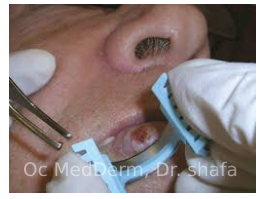
This method is used in the following cases:
- if we need a tissue sample before completely removing a skin lesion
- if the lesion is large and needs debulking prior to the mole or skin lesion removal
- if the lesion is sitting on the skin and not invading skin layers
The procedure is shaving the mole off of the skin level. Then, the site of shaving will be cauterized (have a solution applied to stop the bleeding). Both methods create a fake scab that covers the area of mole removal and allows the wound to heal beneath it. The removed tissue can be sent to a pathologist for a final confirmed diagnosis.
3. Punch Biopsy
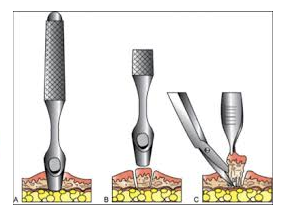
After we anesthetize the suspicious area, a special medical device can be used to “punch out” a cylinder-shaped piece of skin and tissue. It will then be sent to a laboratory for further examination.
This method can be used for the removal of suspicious moles or any deep skin lesions when a deeper tissue layer under the mole is needed for evaluation to rule out cancer. It is usually used in areas of the body that you are not concerned with a result of scarring. The area can be closed with one or two stitches or left alone to close by itself.
4. Mole Excision
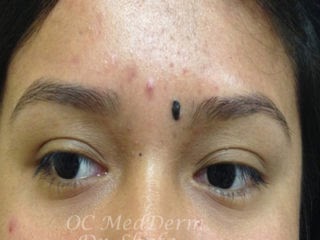
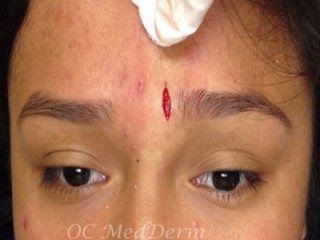
This method is used when a mole is deep in the skin, diagnosis is uncertain, or if there is a suspicion of skin cancer. During this procedure, we need a reasonably sized, thick piece of tissue for the pathologist to evaluate under a microscope. The area will be completely numbed and the mole will be cut out in an eye shape with some of the skin around it. The cut area will be closed with stitches, and a follow-up appointment will be needed to ensure it is healing well.
Natural Mole Removal


There is a wide variety of “natural mole removal” creams and pastes on the market. Most of these products contain Blood-root, an herb in the field of alternative medicine, as a supposed method of mole removal.
This treatment option claims that applying this cream to the mole will cause it to turn brown and fall off. We highly discourage you to use these products for your mole removal. Remember that moles are deep in the skin, meaning that they do not scab and “fall off”. If a chemical such as TCA is deeply penetrated into the skin to destroy the mole, then it will leave a cigarette burn like a scar. In most of the cases, half of the colored mole is still visible under the scar or starts showing up again a few months later.
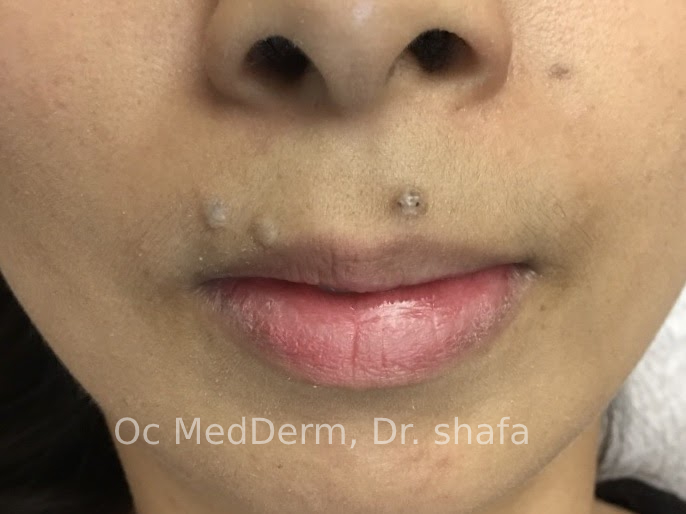
More importantly, a mole needs to be evaluated and biopsied by a physician before it is destroyed to rule out skin cancer.
The above patient had an improper procedure (laser) done on her moles which caused scars at the site of the moles. The result of destructive topical agents is similar to an incorrect laser procedure. The scar left behind can oftentimes be worse than the original mole.
How long does it take to heal?
Healing after treatment depends on many factors, such as location, size, and method used to remove the mole. Generally, it can take 1 to 2 weeks for the lesion to heal. If there is a residual pink mark, it can take up to six months to fade back to skin-colored. Results may vary, so Dr. Shafa will inform you of exactly what to expect for the healing process in your individualized case.
Do we have to send the removed mole to a pathologist if it looks like a benign mole?
In the practice of medicine, physicians follow a protocol of “Standard Care.” It means that every doctor is expected to send a removed mole to the pathologist even if it clinically looks benign. This is because even the most experienced dermatologists cannot be 100% sure with the naked eye that there are not any cancer cells developing within the mole. In the case that there are cancer cells developing within the site of removal, a wider tissue re-excision is recommended.
Other Treatments
Why Choose Us for Your Skin Surgery | Mole Overview | Typical Moles | Atypical Moles | Other Skin Lesions That Might Look Like Moles | Mole Gallery
Schedule a Consultation
